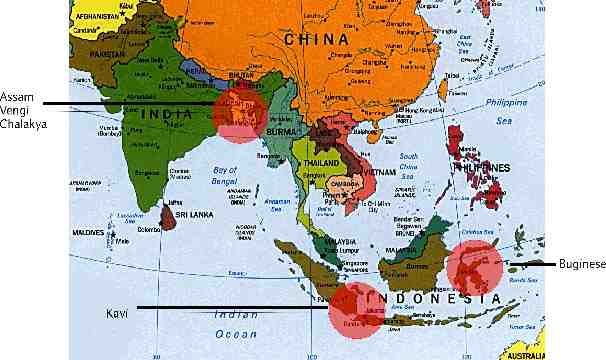 |
 font |
 books |
 links |
 credits |
 how-to |
 transliterator |
| contents | origins | artifacts | language | usage | extinction | revival |
|---|
Origins of Alibata
Although the major languages of the Philippines are now written using the Roman alphabet, the languages were first represented using a script related to and directly or indirectly derived from the scripts of India. The script has had a rather short history, having come into use around AD 1000-1200.1 and for the most part becoming extinct in the late 18th century.2 However, two forms of the indigenous scripts still survive to present day: the script used by the Tagbanwa from the island of Palawan, and the script used by the Mangyan from the island of Mindoro.3 In truth, however, the origin of the script has not yet been ascertained, and various theories abound.
The term Alibata
The script is often referred to as alibata, a term coined inexplicably to mimic the first two letters of the alphabet of the Maguindanao, used in the southern Philippines, which is derived from Arabic. (The term refers to the first two letters, alif and bet.) It is also called baybayin, which means "to spell" in Tagalog.
Theory: Originated in Celebes
One of the most common explanations, given by David Diringer, states that the Philippine scripts were derived from Kavi script or Old Javanese, perhaps indirectly through the Buginese.4 The Buginese origin of the Philippine scripts best accounts for the fact that the Philippine scripts cannot represent the final consonants of syllables, since Buginese has the same limitation. In Buginese, however, this limitation is not as noticeable, since fewer words in the language have these final consonants.5
Theory: Directly from India
Fletcher Gardner suggests that the writing system was directly transmitted to the Philippines by Indian priests who were familiar with Brahmi scripts. 6 Isaac Taylor states that the writing system was derived from scripts used on the Eastern coast of India, such as Vengi, Chalukya, or Assam, originally transmitted in the 8th century AD. In this case, the Philippine scripts would actually be the sources for the Bugis and Makassar scripts of Celebes instead of the other way around.7
Map of putative sites of origin
FIGURE 1

Map derived from
http://www.lib.utexas.edu/Libs/PCL/Map_collection/middle_east_and_asia/Asia_pol_97.jpg
[ Documents and Artifacts which use Alibata ] [ Languages rendered by Alibata ]
[ Features (Usage guide) ] [ Reasons for extinction ]
[ Attempts to revive and reform the writing system ]
2Scott, William Henry. Prehispanic Source Materials: For the Study of Philippine History. (Quezon City: New Day Publishers, 1984) 56.
3Diringer, David. The Alphabet: A Key to the History of Mankind. (New York: 1948) 437.
4Diringer 440-1